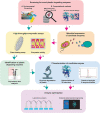Toward Microbial Recycling and Upcycling of Plastics: Prospects and Challenges
- PMID: 35401461
- PMCID: PMC8985596
- DOI: 10.3389/fmicb.2022.821629
Toward Microbial Recycling and Upcycling of Plastics: Prospects and Challenges
Abstract
Annually, 400 Mt of plastics are produced of which roughly 40% is discarded within a year. Current plastic waste management approaches focus on applying physical, thermal, and chemical treatments of plastic polymers. However, these methods have severe limitations leading to the loss of valuable materials and resources. Another major drawback is the rapid accumulation of plastics into the environment causing one of the biggest environmental threats of the twenty-first century. Therefore, to complement current plastic management approaches novel routes toward plastic degradation and upcycling need to be developed. Enzymatic degradation and conversion of plastics present a promising approach toward sustainable recycling of plastics and plastics building blocks. However, the quest for novel enzymes that efficiently operate in cost-effective, large-scale plastics degradation poses many challenges. To date, a wide range of experimental set-ups has been reported, in many cases lacking a detailed investigation of microbial species exhibiting plastics degrading properties as well as of their corresponding plastics degrading enzymes. The apparent lack of consistent approaches compromises the necessary discovery of a wide range of novel enzymes. In this review, we discuss prospects and possibilities for efficient enzymatic degradation, recycling, and upcycling of plastics, in correlation with their wide diversity and broad utilization. Current methods for the identification and optimization of plastics degrading enzymes are compared and discussed. We present a framework for a standardized workflow, allowing transparent discovery and optimization of novel enzymes for efficient and sustainable plastics degradation in the future.
Keywords: biodegradation; biorecycling; comprehensive workflow; enzymes; plastics.
Copyright © 2022 Verschoor, Kusumawardhani, Ram and de Winde.
Conflict of interest statement
The authors declare that the research was conducted in the absence of any commercial or financial relationships that could be construed as a potential conflict of interest.
Figures


Similar articles
-
The Minderoo-Monaco Commission on Plastics and Human Health.Ann Glob Health. 2023 Mar 21;89(1):23. doi: 10.5334/aogh.4056. eCollection 2023. Ann Glob Health. 2023. PMID: 36969097 Free PMC article. Review.
-
Biodegradation and up-cycling of polyurethanes: Progress, challenges, and prospects.Biotechnol Adv. 2021 May-Jun;48:107730. doi: 10.1016/j.biotechadv.2021.107730. Epub 2021 Mar 10. Biotechnol Adv. 2021. PMID: 33713745 Review.
-
MIXed plastics biodegradation and UPcycling using microbial communities: EU Horizon 2020 project MIX-UP started January 2020.Environ Sci Eur. 2021;33(1):99. doi: 10.1186/s12302-021-00536-5. Epub 2021 Aug 21. Environ Sci Eur. 2021. PMID: 34458054 Free PMC article.
-
Recent advances in recycling and upcycling of hazardous plastic waste: A review.J Environ Manage. 2025 Apr;380:124867. doi: 10.1016/j.jenvman.2025.124867. Epub 2025 Mar 12. J Environ Manage. 2025. PMID: 40068335 Review.
-
Exploring biotechnology for plastic recycling, degradation and upcycling for a sustainable future.Biotechnol Adv. 2025 Jul-Aug;81:108544. doi: 10.1016/j.biotechadv.2025.108544. Epub 2025 Feb 28. Biotechnol Adv. 2025. PMID: 40024585 Review.
Cited by
-
Collaborating for Impact: Navigating Partnerships and Overcoming Challenges across the Sustainable Development Goals.ACS Sustain Chem Eng. 2025 Jan 16;13(3):1164-1173. doi: 10.1021/acssuschemeng.4c10171. eCollection 2025 Jan 27. ACS Sustain Chem Eng. 2025. PMID: 39886474 Free PMC article.
-
Enzyme catalyzes ester bond synthesis and hydrolysis: The key step for sustainable usage of plastics.Front Microbiol. 2023 Jan 12;13:1113705. doi: 10.3389/fmicb.2022.1113705. eCollection 2022. Front Microbiol. 2023. PMID: 36713200 Free PMC article. Review.
-
XTT assay for detection of bacterial metabolic activity in water-based polyester polyurethane.PLoS One. 2024 Jun 6;19(6):e0303210. doi: 10.1371/journal.pone.0303210. eCollection 2024. PLoS One. 2024. PMID: 38843174 Free PMC article.
-
Engineering Comamonas testosteroni for the production of 2-pyrone-4,6-dicarboxylic acid as a promising building block.Microb Cell Fact. 2023 Sep 19;22(1):188. doi: 10.1186/s12934-023-02202-2. Microb Cell Fact. 2023. PMID: 37726725 Free PMC article.
-
Biocomposite thermoplastic polyurethanes containing evolved bacterial spores as living fillers to facilitate polymer disintegration.Nat Commun. 2024 Apr 30;15(1):3338. doi: 10.1038/s41467-024-47132-8. Nat Commun. 2024. PMID: 38688899 Free PMC article.
References
-
- Abed M., Aziz E. (2019). A Review on Saponins from Medicinal Plants: chemistry, Isolation, and Determination. J. Nanomed. Res. 8 282–288. 10.15406/jnmr.2019.08.00199 - DOI
-
- Almeida E. L., Rincón A. F. C., Jackson S. A., Dobson A. D. W. (2019). In silico Screening and Heterologous Expression of a Polyethylene Terephthalate Hydrolase (PETase)-Like Enzyme (SM14est) With Polycaprolactone (PCL)-Degrading Activity, From the Marine Sponge-Derived Strain Streptomyces sp. SM14. Front. Microbiol. 10:2187. 10.3389/fmicb.2019.02187 - DOI - PMC - PubMed
-
- Álvarez-Barragán J., Domínguez-Malfavón L., Vargas-Suárez M., González-Hernández R., Aguilar-Osorio G., Loza-Tavera H. (2016). Biodegradative activities of selected environmental fungi on a polyester polyurethane varnish and polyether polyurethane foams. Appl. Environ. Microbiol. 82 5225–5235. 10.1128/AEM.01344-16 - DOI - PMC - PubMed
-
- Anbalagan S., Raghava H., Venkatakrishnan R., Ravindran J., Sathyamoorthy J., Rangabashyam K. A., et al. (2021). Hydrolytic Degradation of Polyethylene Terephthalate by Cutinase Enzyme Derived from Fungal Biomass–Molecular Characterization. Biointerface Res. Appl. Chem. 12 653–667. 10.33263/briac121.653667 - DOI
Publication types
LinkOut - more resources
Full Text Sources

